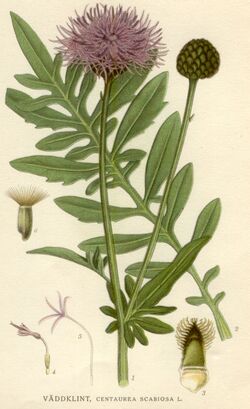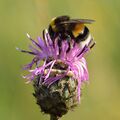Biology:Centaurea scabiosa
| Centaurea scabiosa | |
|---|---|

| |
| Scientific classification | |
| Kingdom: | Plantae |
| Clade: | Tracheophytes |
| Clade: | Angiosperms |
| Clade: | Eudicots |
| Clade: | Asterids |
| Order: | Asterales |
| Family: | Asteraceae |
| Genus: | Centaurea |
| Species: | C. scabiosa
|
| Binomial name | |
| Centaurea scabiosa | |
Centaurea scabiosa, or greater knapweed, is a perennial plant of the genus Centaurea. It is native to Europe and bears purple flower heads.
Greater knapweed is found growing in dry grasslands, hedgerows and cliffs on lime-rich soil. Upright branched stems terminate in single thistle-like flowerheads, each having an outer ring of extended, purple-pink "ragged" bracts which form a crown around the central flowers. The plant has deeply dissected leaves which form a clump at the base.
This species is very valuable to bees. It is also a magnet for many species of butterfly. Among them is the marbled white.
This is the only known food plant for caterpillars of the Coleophoridae case-bearer moth Coleophora didymella. Centaurea scabiosa has been used in traditional herbal healing as either a vulnerary or an emollient.
The plant is sometimes confused with devils-bit scabious, however the leaves on this plant are arranged alternately, whereas in devils-bit they are opposite.[1]
Description
This perennial herb grows with an erect grooved stem up to 90 cm high. The leaves are alternate, pinnatifid and with stalks. The flower heads are 5 cm across and on long stalks. The florets are red-purple.[2][3]
Habitat
Dry grassland, roadsides and calcareous substrate.[3]
Distribution
Found in Great Britain and Ireland.[3]
Images
References
- ↑ Rose, Francis (1981). The Wild Flower Key. Frederick Warne & Co. pp. 385–387. ISBN 0-7232-2419-6.
- ↑ Parnell, J. and Curtis, T. 2012. Webb's An Irish Flora Cork University Press.ISBN:978-185918-4783
- ↑ 3.0 3.1 3.2 Clapham, A.R., Tutin, T.G. and Warburg, E.F. 1968 Excursion Flora of the British Isles. Cambridge University PressISBN:0-521-04656-4
- The Wild Flower Key British Isles-N.W. Europe by Francis Rose, page 385
External links
Wikidata ☰ Q1569852 entry
 |






